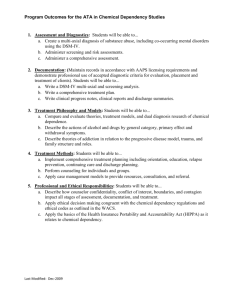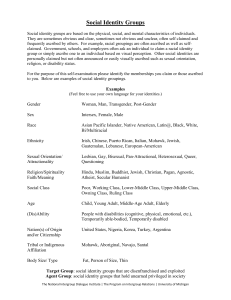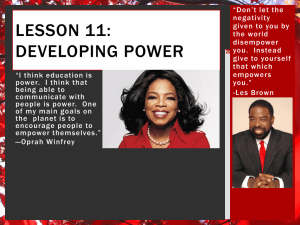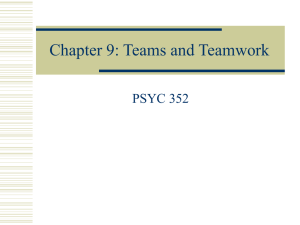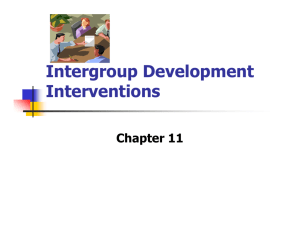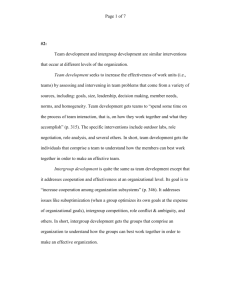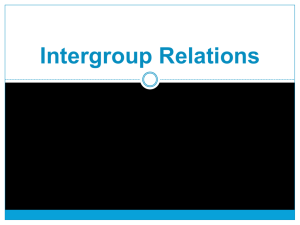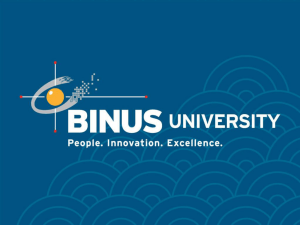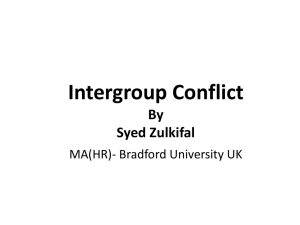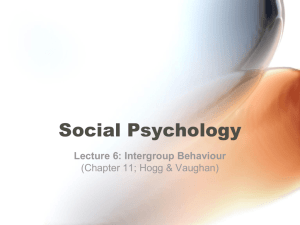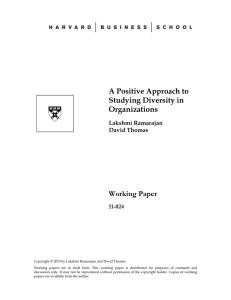- easynotes
advertisement
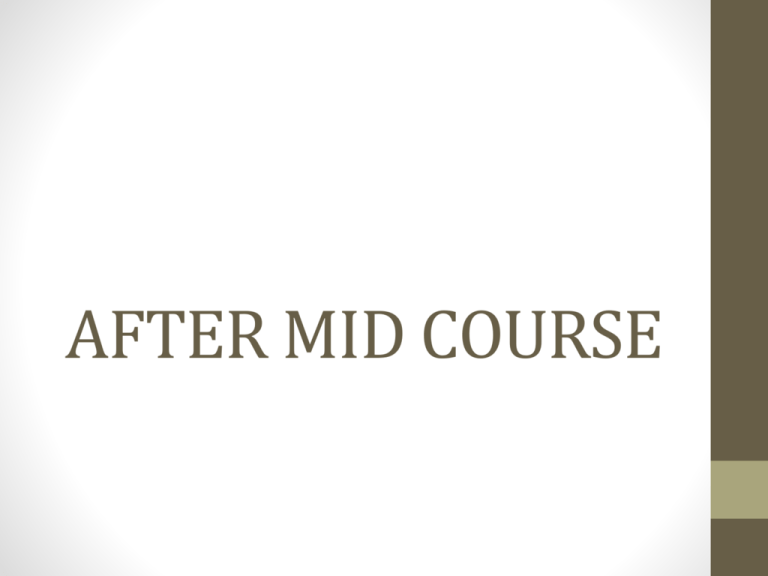
AFTER MID COURSE Leadership Power and Influence 2 “If a man can accept a situation in a place of power with the thought that it’s only temporary, he comes out all right. But when he thinks that he is the cause of the power, that can be his ruination.” • Harry S. Truman 3 Power and Influence Power • The ability of one person or department in an organization to influence other people to bring about desired outcomes Influence • The effect a person’s actions have on the attitudes, values, beliefs, or actions of others 4 . Ex 12.2 Five Types of Leader Power •Legitimate •Reward •Coercive •Expert •Referent Position Power Personal Power 5 Where does power come from? Position power • A written, spoken, or implied contract wherein people accept either a superior or subordinate role and see the use of coercive as well as noncoercive behavior as an acceptable way of achieving desirable results. 6 Legitimate Power • Authority granted from a formal positions in an organization. • Rights, responsibilities and prerogatives accrue to anyone holding a formal leadership position • Set goals, make decisions and direct activities 7 Reward Power • Authority to bestow rewards on other people • Appointed leaders may have access to rewards such as pay increases, promotions, physical resources • Influences subordinate’s behavior 8 Coercive Power • Authority to punish or recommend punishment • Opposite of reward power • Right to fire, demote, criticize, reprimand or withdraw pay raises 9 Expert Power • Results from special knowledge or skill • Followers go along with recommendations because of his/her superior knowledge • Usually gained from experience 10 Referent Power • Comes from personality characteristics that command identification, respect and admirations so that others want to emulate the person • Dependent on personal characteristics rather than title • Strong identification with leader 11 . Ex 12.3 Responses to the Use of Power Position Power Compliance Resistance Personal Power Commitment 12 Dependency • If a person has control over a resource that is desired, he/she gains power • Information • Cooperation • Resources 13 Ex. 12.4 Characteristics That Affect Dependency and Power in Organizations Leader has control over: Leader has control over: Resources seen as unimportant Importance Resources seen as very important Widely available resources Scarcity Scarce resources Resources with acceptable substitutes Low dependency on leader = lower power Non substitutability Resources with no substitutes High dependency on leader = higher power 14 . Ex 12.5 Strategic Contingencies that Affect Leader Power in Organizations Interdepartmental Dependency Control over Information Increased Power Organizational Centrality Coping with Uncertainty 15 Politics Activities to acquire, develop, and use power and other resources to obtain desired future outcomes when there is uncertainty or disagreement about choices 16 Political Activity • Impression management – people seek to control how others perceived them • Executive presence – the impact you have when walk into a room 17 . Seven Principles for Asserting Leader Influence Ex 12.6 1. 2. 3. 4. 5. 6. 7. Use rational persuasion Make people like you Rely on the rule of reciprocity Develop allies Ask for what you want Remember the principle of scarcity Extend formal authority with expertise and credibility 18 Guidelines for Ethical Action Is the action consistent with the organization’s goals, rather than being self-motivated purely by selfinterest? Does the action respect the rights of individuals and groups affected by it? Does the action meet the standards of fairness and equity? Would you wish others to behave in the same way if the action affected you? Ethical Choice Ex. 12.7 19 Leadership in Organizations Leader as Maker of Culture way of controlling behavior from the inside out rather than the outside in. Seven characteristics that capture organizational culture 1) INNOVATION AND RISK TAKING: apple, Walmart is into cost minimization, take less risks. 2) ATTENTION TO DETAIL: precision, analysis and attention to detail 3) OUTCOME ORIENTATION: results or process. 4) PEOPLE ORIENTATION: people friendliness or technical oriented. management considers people when making decisions. 5) TEAM ORIENTATION: team or individual 6) AGGRESSIVENESS: or easy going. 7) STABILITY: vs change, pursuit of the status quo rather than growth or change The Leader as Sense maker Today’s leaders need the ability to make sense of complex environments. Sensemaking — the ability to make sense of what’s going on in a changing and complex environment — is a particularly important predictor of leadership effectiveness right now Sensemaking in business (a term drawn from the works of Karl Weick) requires executives to let go of their old mental models and some of their core assumptions; to take in data from a wide variety of sources; to use the information they have to construct, with others, a “map” of what they think is going on; and to verify and update the map — in part by conducting small experiments that provide the organization with more information. The Functions of Leadership in Organization • “Leadership is a process of social influence in which one person is able to enlist the aid and support of others in the accomplishment of a common task.” • Key points: • Leadership is a group activity. • Leadership is based on social influence. • Leadership revolves around a common task. The Functions of Leadership in Organization • The specification seems simple, but the reality of leadership is complex. • Intrapersonal factors (i.e., thoughts and emotions) interact with; • Interpersonal processes (i.e., attraction, communication, influence) to have effects on; • A dynamic external environment. The Organizational Functions of Leadership • Leadership is a process of social influence through which one person is able to enlist the aid of others in reaching a goal. The Organizational Functions of Leadership • In an orderly, structured, and well-understood environment, the primary responsibilities are guidance and motivation. • Assign people to tasks or responsibilities, to outline what is expected, and to facilitate and encourage goal attainment. The Organizational Functions of Leadership • In a less orderly environment calling for external adaptability, the crucial functions are problem solving and innovation. • The leader must create the kind of atmosphere that encourages sensitivity, flexibility, and creativity. • The leader must be a change agent. Intergroup leadership • leadership of collaborative performance of different organizational groups or organizations—is associated with unique intergroup challenges that are not addressed by traditional leadership theories. • To address this lacuna, we describe a theory of intergroup leadership. • Firmly grounded in research on social identity and intergroup relations, the theory proposes that effective intergroup performance rests on the leader’s ability to construct an intergroup relational identity. • We describe key leadership actions to establish such an identity. Public Leadership Public Leadership Considered 1. 2. 3. 4. Public Leadership: The Concepts Understanding the public leadership Public Leadership: The Challenges Public Leadership: The Competencies Public Leadership: The Concepts Public Leadership: The Concepts • Author’s definition: “Democratic and effective public leadership is action taken through a dynamic and transparent process involving the leader with relevant others in the inclusive setting and effective realization of legitimate, legal and socially valuable goals and objectives. The process requires continuous democratic and organizational learning to progressively enhance effective and proper policy making and service delivery aimed at improving the quality of lives of citizens.” Understanding Public Leadership: A Good versus Bad Public Leadership Perspective • • • • Reclaiming Bad Public Leadership for learning purposes Kellerman, Lipman-Blumen Bad Public Leadership: Ineffective and/or Unethical Types of bad leadership: • • • • • • • Incompetent Rigid Intemperate Callous Corrupt Insular Evil Remedies to Bad Public Leadership • Limit tenure • When leaders remain in positions of power for too long, they tend to acquire bad habits • Share power • When power is centralized, it is likely to be misused, and that puts a premium on delegation and collaboration • Don't believe your own hype • For leaders to buy their own publicity is the kiss of death • Get real, and stay real • Virtually every bad leader lost touch with reality to some degree • Compensate for your weaknesses • Stay balanced • Balanced leaders develop healthier organizations, make more thoughtful decisions and lead more effectively Remedies to Bad Public Leadership • Remember the mission • Arguably this matters most when the group or organization is dedicated to public service • Stay healthy • Develop a personal support system • All of us should have aides, associates, friends, or family members who will save us from ourselves • Every leader can benefit from tough love • Be creative • The past should never determine the future nor narrow the available options Remedies to Bad Public Leadership • Know and control your appetites • These include the hunger for power, money, success and sex • Be reflective • Virtually every one of the great writers on leadership - Plato, Aristotle, Lao Tzu, Confucius, Buddha - emphasizes the importance of self-knowledge, self-control, and good habits • Acquiring and sustaining such virtues is hard • Toxic Leadership: Lipman-Blumen: Why do we suffer, tolerate, accept and even support toxic leaders? Public Leadership: The Challenges Public Leadership: The Challenges • Increasing the understanding of the variety of developments that are frequently characterised as globalisation; the globalisation challenge • The realisation that the public problems which governments now most frequently deal with have grown in number; they are also becoming even more complex and there appear to be no clear-cut solutions, or right or wrong answers for many of them; the complexity challenge Public Leadership: The Challenges • The growing gap between the rich and the poor in both the developed industrialised countries and the less economically well-developed transitional countries; the inequality challenge • The critical need to further address issues of gender equality, especially in the area of educational opportunities in all societies; the gender equality challenge • The growing incorporation of norms of cultural diversity into all sectors of society, with the consequent escalating demands for the direct representation of cultural and ethnic interests and heritages in the processes of public administration and governance; the diversity challenge Public Leadership: The Challenges • The considerable movement toward political democratisation with its greatly increased emphasis on ethical behaviour in government, civil service transparency and accountability; the good governance challenge • The gradual weakening of state capacity and in some cases the actual disintegration of the state; the capacity challenge • The combination of a decrease of trust in government institutions, and the growth of multinational integration, leading to the increased disintegration of the capacity of the nation state; the erosion of confidence challenge Public Leadership: The Challenges • The rapidly growing interest in the decentralisation of previously centralised governance institutions and the broadening of local governance capacity; the local empowerment and capacity challenge • The continued search for optimal solutions to optimise the structures and functioning of policy implementation and service delivery systems, recently new public management approach emphasising market-based options to address public policy needs linked to significant increases in utilising private or non-profit sector institutions and/or “solutions” for delivering public programmes; the administrative reform challenge. Public Leadership: The Competencies Public Leadership: The Competencies • Rosenbaum (2003) lists twelve areas in which public leaders should be competent. These are: • • • • • • adapting rapidly to change and complexity, fostering effective collaboration, being able to see situations as others see them, building democratic institutions, fostering ethical awareness and sensitivity, enhancing capacity for self-management, Public Leadership: The Competencies • • • • entrepreneurship and a risk-taking ability, strategic planning capability, capability to enhance people development, capacity to board and nurture of harmonious multi-ethnic, multicultural and gender equitable situations, • ability to focus in an increasingly diffuse and complex environment, • capacity to persuasively communicate complex messages orally and in writing.

